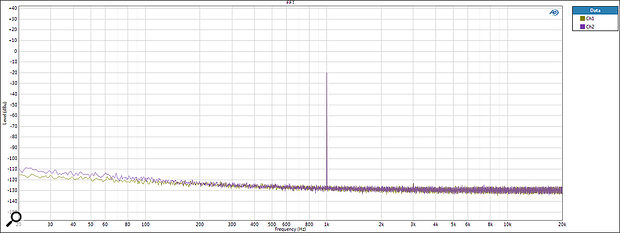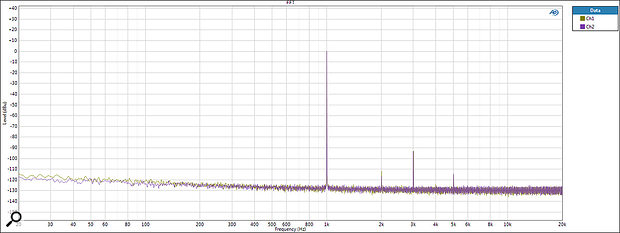Watch the product launch video from NAMM 2019, earlier this year.
Outputs
The KL‑8's output section is delineated by a black background, and starts with a rotary knob for the aux return level (which can be used as a fifth stereo instrument input, if required). Two more knobs adjust the main and monitor output levels, each with buttons to turn their respective outputs on and to sum the stereo signal to mono. Unusually, there is no output level metering, and nothing to indicate whether the unit is configured in its Live or Rec modes either — not even a status LED by the rear-panel button, which could easily get knocked while plugging USB leads in.
Turning the main output control down to the nine o'clock positon introduces about 30dB of attenuation, reducing the nominal line output down to that of a strong microphone signal, should that be required when plugging into a stage snake. The transformer‑isolated outputs are tolerant of, and protected against, phantom power on the connecting lines, of course.
A headphone volume control completes the front panel, driving an adjacent pair of standard, paralleled, quarter-inch TRS sockets. These powerful outputs normally carry the monitor mix, but this is replaced with direct input channels when the Cue buttons are pressed (a red LED shows when the Cue system is active).
The KL‑8 is an impressive keyboard mixer with a well-focused feature set, superb flexibility and configurability, great technical performance, and solid reliability.
Finally, one additional configuration slide-switch is recessed into the KL‑8's top panel. While this is not a very convenient location on a rackmounting device it's an option that will rarely need to be changed, and there simply isn't any front- or rear-panel space available elsewhere anyway! This switch determines the signal routing for the auxiliary return, with the factory setting (labelled 'All Outputs') bringing it directly into the main mix bus to be heard in the main, monitoring and headphone outputs. Flipping the switch removes the aux returns from the main mix completely, so that they are only audible through the monitoring and headphone outputs ('Monitor & Headphones Only'). This latter condition is intended for performers who need to monitor a click track, say, without passing it on to the mix outputs. So the click-track signal would be connected to the aux return and adjusted with the aux return volume knob. The normal instrument input channels can still contribute to the aux send, of course, but any send/return effects would need to be brought back into the mix via one of the other instrument channels.
In Use
As the USB interfacing is class compliant, no drivers are required when connecting to a Mac, but a driver is required for Windows platforms (free on the Radial web site: Xmos 3060 v4.11 at the time of writing). Unfortunately, when connected to either a powerful Windows 7 desktop machine or an MS Surface 4 (i7 and Windows 10), I found this Xmos driver demanded a buffer size of 1700+ samples with an 18ms latency, and it produced regular clicks and splats. However, the Radial web site recommends installing asio4all after the Xmos driver and, using that instead, I was able to obtain reliable working with a buffer size of 128 samples.
Playing virtual instruments and backing tracks from the computer worked fine in both the Live and Rec modes, and the KL‑8's gain structure is set up so that full-scale digital audio from the computer can't overload the stereo mix bus even with the USB level control flat out. This is obviously very sensible and guarantees that soft synths or backing tracks can't cause any accidental clipping within the KL‑8. In fact, with the USB control maximised, a 0dBFS replay signal reaches the stereo mix bus at +10dBu, and delivers +18dBu at the main outputs if the output control is maxed too.
However, a side-effect of this gain structure is that a USB-recorded performance replays noticeably quieter than the source. For example, with a keyboard input set to give 0dBu at the mix bus, the digital signal reaching the DAW is -18dBFS, which leaves a generous headroom margin. But playing that recorded signal back produces an output which is 8dB quieter than the live keyboard, even with the USB level control at maximum (and it's the same in both the Live and Rec configurations). I raised this disparity with Radial, who acknowledged my observation but said: "The ability to use the KL‑8 as a recording interface is more of an additional feature than a primary application."
I take the point. The KL‑8 is, first and foremost, a live-performance keyboard mixer with integrated USB replay facility, and it sounds great and works extremely well in that context, and many will be willing to overlook the level discrepancy and consider the ability to also record over USB a useful extra, rather than thinking of the KL‑8 as a dedicated recording interface. Personally, though, I find it disappointing as it limits the KL‑8's convenience in a studio situation. However, for studio working it would have been far more attractive if the unit incorporated a multi-channel USB output so that each keyboard part could be captured individually on its own (stereo) track in the computer. So I also raised this thought with Radial who responded that they, "didn't want to directly compete with the saturated market that exists for multichannel studio recording interfaces". Again, I can't argue with that stance, although I can't help thinking that a multi-channel recording capability with a consistent record-replay gain structure would have elevated the KL‑8 into a genuinely great live/studio all-rounder keyboard interface — one which would be unique in the current market meeting the demands of session keyboardists everywhere!
Nevertheless, the KL‑8 is an impressive keyboard mixer with a well-focused feature set, superb flexibility and configurability, great technical performance and solid reliability. Its rackmount format and slightly altered features set complements the Key Largo, and will appeal to a different subset of customers. I enjoyed using it a great deal, and found it a genuine asset in my own live keyboard rig.
Tech Specs
 Lifting the lid reveals a large PCB populated with mostly surface-mount devices, with sockets and controls attached directly to the board.
Lifting the lid reveals a large PCB populated with mostly surface-mount devices, with sockets and controls attached directly to the board.
The KL‑8s internal construction is to a very high standard, and should prove rugged and reliable over a long lifespan. A single PCB, carrying mainly surface-mount components, occupies the full floor area of the chassis, with all the controls and connectors attached directly to the board. Two small, vertical daughter cards carry the USB interfaces (the same well-proven design employed in the Key Largo). Each sub-board features an XMOS USB-handling chip and a Cirrus Logic CS4270 stereo A-D/D-A converter, which supports 24-bit audio at all standard sample rates up to 192kHz with a quoted dynamic range of 105dB.
Presumably as a result of the revised powering arrangements, the KL‑8 has more headroom than its sibling, with the balanced main and monitor outputs clipping at +28dBu (4dB higher), while also accommodating 6dB more instrument input level (clipping at +18dBu). The unbalanced aux send output can manage +18dBu, which is fine but — unexpectedly — the aux return input clips at +11dBu. The signal-to-noise ratio measures -90dB (ref +4dBu), and THD measures 0.002 percent (same reference level) with predominantly third-order harmonics (although the harmonic balance levelled out with more conventional instrument input levels (-20dBu). A high‑resolution FFT analysis of the quiescent noise-floor showed it to be completely free of any mains-related hum components and averaged around -120dBu, which is impressive.
 FFT analysis reveals an average noise floor around -120dBu, and no mains-related hum whatsoever.
FFT analysis reveals an average noise floor around -120dBu, and no mains-related hum whatsoever. As the output is pushed, more second-harmonic distortion is generated.
As the output is pushed, more second-harmonic distortion is generated.
The analogue audio signal paths are processed through low-noise Texas Instruments OPA1664 quad op-amps (although I also spotted an LM3234 quad op-amp in the sux send/return circuitry), and sealed relays take care of signal path reconfigurations and aux send/return muting. Crosstalk between left and right input channels measured a respectable -59dB at 10kHz and a healthy -85dB at 1kHz, while the channel 'off-ness' measured -78dB with the On button released, and -72dB when the level knob was at minimum.
Frequency response measured flat (±0.5dB) between 20Hz and 20kHz when the output was connected to typical destinations with impedances between 10-50 kΩ. However, both the high-end response and overall output level are affected by unusually high- or low-impedance destinations. Anything above 100kΩ emphasises a 50kHz resonance peak in the output transformers, while connecting a destination impedance of 600Ω causes the overall output level to drop by around 9dB and roll off above 18kHz. Thankfully, neither condition is likely to occur in normal KL‑8 applications.
Running my usual AES17 dynamic range test on a round-trip through both A-D and D-A stage via the USB interface, I obtained 105dB (A-weighted), matching the converter chip's theoretical performance and indicating a very good circuit implementation. Obviously this dynamic range figure falls short of current high-end converter performance (which is pushing past 120dB these days), but I'd argue it is entirely acceptable for the intended application.
The headphone amp can deliver 0.4 Watts per channel into 15Ω (8.3V RMS maximum voltage), and I found it capable of a generous volume when using a range of typical studio headphones and in-ear monitors.
Pros
- Four stereo instrument inputs, plus stereo aux loop and USB replay.
- Excellent audio performance, with generous headroom and very clean and low noise floor.
- Two transformer-isolated stereo outputs with ground-lift switches.
- Powerful headphone monitoring with cue facility.
- Integrated stereo USB interface with main/reserve switching and versatile Live/Rec configurations.
- Configurable for a variety of different setups, but simple to operate on stage.
Cons
- Supplied Windows driver seems to have some buffer/latency issues.
- No indication of Live/Rec configuration status.
- External PSU.
- Level metering is very basic.
Summary
A very robust, high-quality, professional rackmounting keyboard mixer designed primarily for live-stage applications, with main/reserve DAW replay facilities and versatile configurability.
information
£775 including VAT.
Polar Audio +44 (0)1444 258258.
